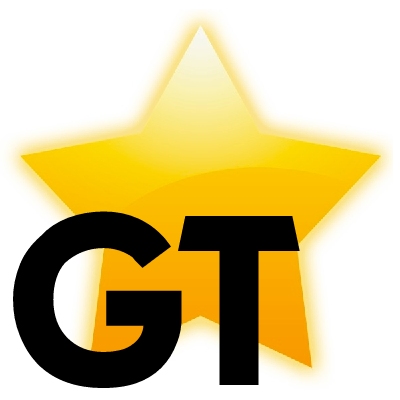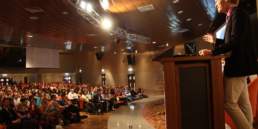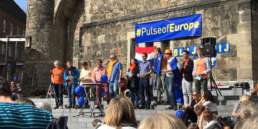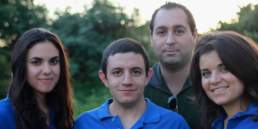There are not many things that Jeroen Hoogerwerf did not do in AEGEE. He was President of AEGEE-Europe in 1992/93, Chairman of the Agora in 1991/92, President of AEGEE-Amsterdam, chief editor of AEGEE’s News Bulletin (the Golden Times of ancient times) and main Agora coordinator in 1991. No wonder that he became Honorary Member of AEGEE-Europe. In the first edition of the new article series about legends of AEGEE, Jeroen looked back at great events, people and funny anecdotes.
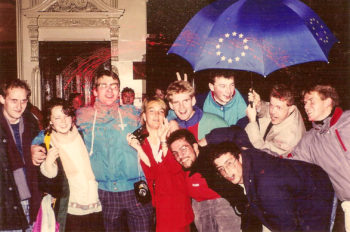
GT: How and when did you join AEGEE?
Jeroen Hoogerwerf: I joined AEGEE in autumn 1987, during the info market of Amsterdam University. I was 18 years old and in my first university year, just enrolled to study history and European studies. A that time we were looking forward to the more integrated EU of the Maastricht Treaty of 1992, so it was interesting to join as association that dealt with Europe.
GT: Soon after, you became President of AEGEE-Amsterdam. How did that happen?
Jeroen: Indeed, it happened very fast. The founders of our antenna, who started it in 1986, were older students. In October 1987 we organised a cultural week, which was a big conference. Amsterdam was the Cultural Capital of Europe in that year. The board asked me to host some people, so I got really fast into AEGEE. Three months later, in January 1988, our treasurer left for studies in the UK, so they asked me to join the board as treasurer. Two months later our president resigned, so I became interim president in March and was officially elected in April 1988. So I was president in 1988/89 – and started to travel.
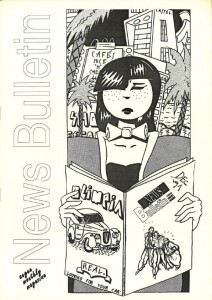
GT: You were chief editor of the very fresh NewsBulletin, which had a huge impact as AEGEE’s main internal information channel before the Internet. How did that happen?
Jeroen: We took over the NewsBulletin when Amsterdam became in the focus of AEGEE, when the AEGEE-Europe headoffice moved to Amsterdam.
GT: What was the reason for that?
Jeroen: In November 1988 there was the “Battle of Orleans”. It was the Agora six months after the end of Franck Biancheri’s term as first president and founder, the Agora where he was supposed to become honorary president of AGEEE. Franck Biancheri was busy with his new association Prometheus and with his political party IDE. It was a bus time in AEGEE. Vieri Bracco was voted President of AEGEE-Europe in April, but he disappeared, so we needed a new one. There were also troubles with AEGEE-Paris and they had problems with Biancheri, too, internal troubles. So we got the headoffice and took over the NewsBulletin. I think CD member Daisy Kopmels from Amsterdam started it.
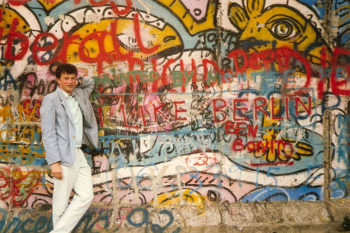
GT: Ah, the girl who created the Summer University project. How did you become chief-editor of the NewsBulletin?
Jeroen: I took over, because we thought it was good to have such a bulletin and we could gather all necessary information in the European head office. I did it while being President of AEGEE-Amsterdam – which was a lot of work. With over 200 members we were one of the biggest antennae in AEGEE at that time. We also helped coordinating the SU in its creation year 1988, by the way. We had one among the first ten SUs! 15 people were coming to Amsterdam, taking part in a Dutch langue course.
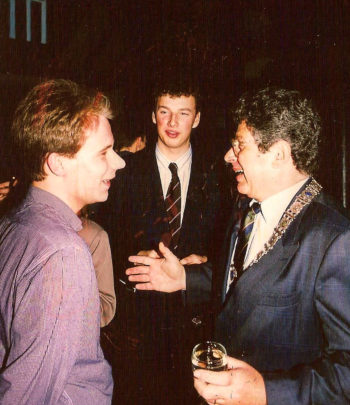
GT: What was the impact of the NewsBulletin on AEGEE?
Jeroen: It had a huge impact. You have to remember, we still used post, faxes and telephone. The NewsBulletin was the first medium of antennae among each other. It was important to have it, especially the Calendar of Events and reports of meetings. And it called for action.
GT: How often was it published?
Jeroen: Every two months, I think. Yes, details disappear in one’s memory.
GT: How did you get the content in the pre-Internet age?
Jeroen: By post and fax mainly. Information on events came via the central office of AEGEE in Amsterdam. We did it for around one year. Then AEGEE-Oviedo took over, because they had good
contacts with the university, and most important financial support.
GT: How was financing and distribution of the NewsBulletin?
Jeroen: The money came out of the budget of AEGEE-Europe. AEGEE got a lot of money from the European Commission at that time, around 75.000 Euros per year.
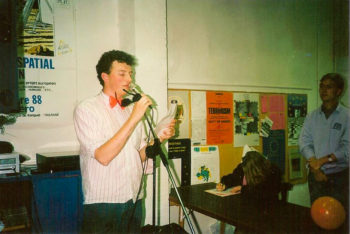
GT: In April 1991 your antenna organised its first of three Agoras with you as main organiser. How do you remember that?
Jeroen: It was the time when AEGEE grew a lot in the East. In 1990 we organised a thematic conference about Japan, where we had the first participants from Central and Eastern Europe. AEGEE-Leipzig founder Michael Merker and his brother took part. His brother was robbed in the red light district, but then the thief saw that he had Ostmark in the wallet. So he returned it with 10 Guilders extra… The year after, in April 1991, we made a conference on the topic of energy with AEGEE-Rotterdam and AEGEE-Leiden, immediately followed by the Agora in Amsterdam. AEGEE-Budapest, AEGEE-Praha and some Polish contacts joined the network there. The Agora was one great party.
GT: How many participants did you have?
Jeroen: We had about 500 participants. It was the first big Agora, that’s when it started to have many people present. Our members lodged all participants.
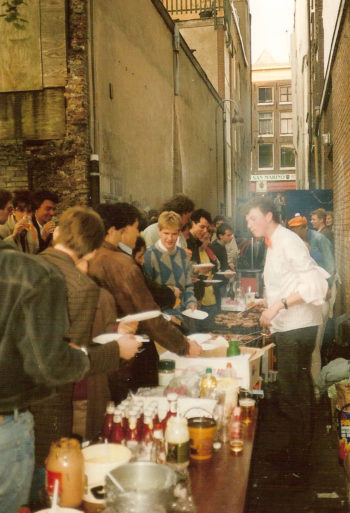
GT: How did you manage that?
Jeroen: We simply called them and told them to take two participants each. “Take them or you won’t be member anymore”.
GT: Your next big career step in AEGEE was being Chairman of the Agora, right? What was your motivation to do it?
Jeroen: I liked the job very much. I was elected Chairman at Agora Amsterdam. I had visited many Agoras already and thought it would be good to see the other side. I like to have results at meetings and that’s what you can achieve as chair. You have only two days and must come to good decisions.
GT: Was it easy to chair the Agoras and Presidents Meetings?
Jeroen: The Presidents Meetings were easier, because there were less people. I have a loud voice, so I could manage. Agora Budapest in autumn 1991 was my first Agora as chair, it was funny. There was a statue of Karl Marx at the end of the hall. Someone asked: “Should we cover Marx, you have to watch him all days?” Of course I said no. Also the Agora in Budapest had around 500 participants. The Presidents Meeting in Kraków in spring 1992 was nice and with about 150 people not too crowded. The organisers of this young antenna wanted to show what Polish people could achieve. I really liked the location – they have one of the nicest and oldest universities, Jagiellonski University.
GT: Agoras were a lot shorter than today – only two days long. Was it hard to make everything in just two days?
Jeroen: It was always very hard, but it’s about time management. If you have a proper agenda, you can push it through. The CD met already on Friday and also several Working Groups met the day before, so some things were prepared well.
GT: Who was your vice chair?
Jeroen: Eric Magielse from AEGEE-Delft. It was a perfect cooperation.
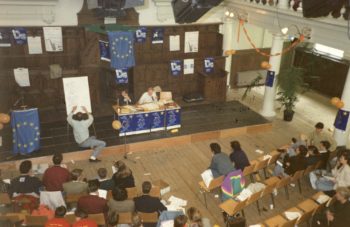
GT: After finishing your term as chairman you became President of AEGEE-Europe in Spring 1992. It was quite an unusual way to do things. How did that happen?
Jeroen: There was nobody who wanted to become president. That’s how it always happened. My predecessor Georg asked me several times to join his CD. As a chair I had close connections with Georg and the CD in general. In spring 1992, when I chaired the PM in Krakow, I was student in Valladolid (where I set up a new antenna with the support of the Foreign Office of the university). Georg and I had several discussions and then he asked me whether I would run as presidential candidate. So I had to find a secretary. First I worked with Marnix Schöyer from AEGEE-Delft, then with Liesbeth Soer from AEGEE-Maastricht.
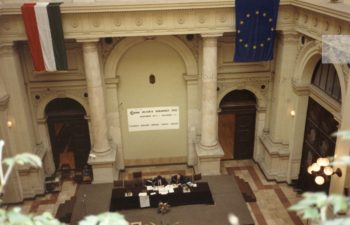
GT: True, at that time president and secretary and to candidate together, in order to ensure a good cooperation. You became President in Kós, which was quite a chaotic Agora. How do remember the fuss about an Agora taking place during Easter and the problems to get to the island of Kós during a ferry strike in Greece?
Jeroen: I had no problems with getting to Kós, since I flew in directly from Spain to Athens. There were also charter flights directly to Kós for Germans and Dutch, so many people had no problem. The location was organised well, the governor of Kós had arranged everything. The organisers from AEGEE-Athina had more problems and were nervous because of the strike of the ferries, which ended just before the Agora started. But everybody managed to get a ferry on time and we were lodged in nice hotels.
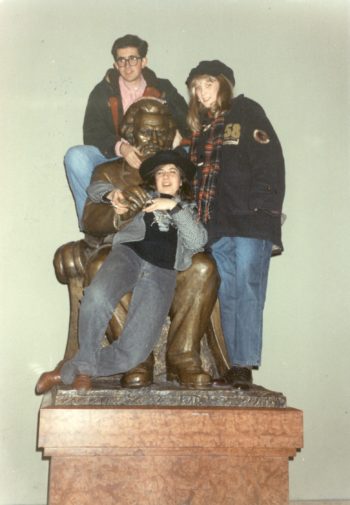
GT: How was that Agora?
Jeroen: The Agora itself was very nice. The only spectacular issue was brought up by AEGEE-Bonn: they wanted to get Turkish locals into the association, which was not very diplomatic to do in Greece. The result: we would vote about it city by city. This principle was reversed at Agora Amsterdam in 1995. I made the proposal myself. So only from then on all Turkish locals could join without problems.
GT: Also the original Statement of Principles was created there.
Jeroen: Yes, Stathis Mihos introduced the Statement of Principles, since Greece is the cradle of democracy. It was a highbrow statement.
GT: How was candidating for president?
Jeroen: I had a double role, being chair and candidate, so my vice chair took over during the elections.
GT: You took over from the Quo Vadis President. Were those big footsteps?
Jeroen: It was actually quite easy to follow him. The office was not in Amsterdam anymore, it had moved to Delft. My secretary general was from Delft, so it was easy to run the association from there. They also had e-mail and Gopher, so we could reach some Internet. As internal communication tool we introduced the CD fax, the weekly newsletter to all CD members. I asked them all for a report weekly, and faxed that to all CD members. The internal communication in the CD was a problem before.
GT: CDs had 16 members back then, living all over Europe and not in one place. How many CD members were actually working?
Jeroen: To be honest, not all 16. We always had some people who did not work, but the majority did.
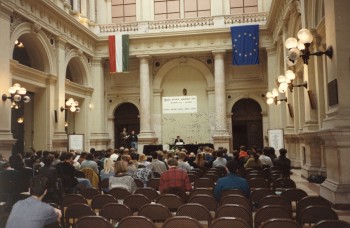
GT: What were the biggest issues of the year Presidency? Any hot topics?
Jeroen: I don’t remember hot issues. The biggest issue was to get the money from the European Commission. That’s why we introduced the Yearplan and made a booklet from it. With this it became more structured what the CD was doing. With this Yearplan we wanted to show what we wanted to achieve. We did not only make it for the European Commission, we realised that it was important for the network as well. AEGEE always organised many serious events – and with the Yearplan we created more visibility.
GT: How did AEGEE develop in that period? Was the big growth in the East slowing down?
Jeroen: Not at all, it was going sky high in that period! Many new locals were created. We had events with whole buses from Hungary and Romania. AEGEE in Bulgaria was developing, too. This development also triggered of discussions on visa issues. There were also troubles with AEGEE-Moskva – the Russian mafia was supposedly behind it.
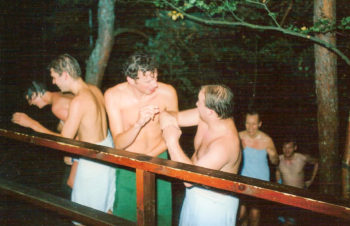
GT: During your presidency, you also had a Presidents Meeting in Turku, the first big event in the North. How was that?
Jeroen: That was great! We had a CD meeting in the sauna and some really good parties. There were 100-150 people – not so many, but it was good to be in the north. We had a CD member from Finland, Paula Kinnunen, her antenna organised it.
GT: How was the cooperation in the CD?
Jeroen: With most people it was really good. We already knew that sixteen was a big number of people, so we started the discussion to reduce the size of the CD.
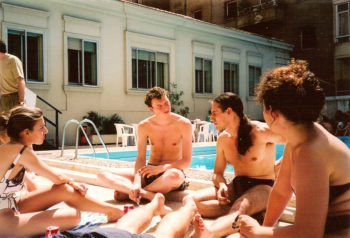
GT: You had the strange nickname Hitler-Stalin-Hoogerwerf. Who invented it? And were you really such a tough person?
Jeroen: Paula Kinnunen created the nickname, probably with Michael Merker. It started when I was chairman, I was quite strict. If you have one minute to speak, you can only speak for a minute. I was also a bit stricter in the CD then Georg was. However, the nickname was clearly exaggerated, if you ask me.
GT: How would you describe your managing style within the CD and towards the network?
Jeroen: I was an integrator. Looking back to my AEGEE time 25 years later, that’s my strength. You have a goal together, you work together – that’s the purpose of AEGEE. There are rules, but I can also be flexible with it. After all, Dutch always go for compromise.
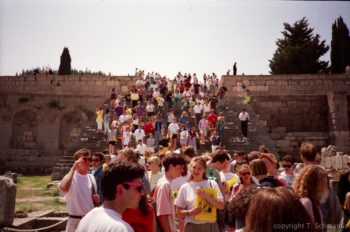
GT: What would you do different as President if you had the chance?
Jeroen: I was 23. I did it the way I am, and probably I would do it the same way now.
GT: At Agora Utrecht in 1993 you became honorary member of AEGEE-Europe. What do you consider as your biggest achievement in AEGEE?
Jeroen: The organisation of the CD, especially the organisation of the Yearplan. By the way, I created three folders of document and advice for my successor, but he lost it in the train the week after…
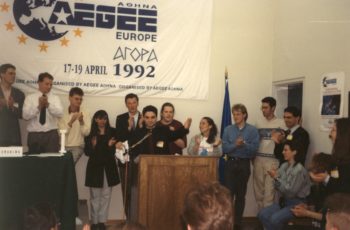
GT: Where do you live now?
Jeroen: I live in De Meern, next to Utrecht. I live there happily with my non-AEGEE wife and three kids.
GT: What do you work now?
Jeroen: I am an educational and children’s book publisher. I have my own company. I write some books myself, but also publish books of others. I started my business three years ago. Before that I was in marketing at a big publishing house, then switched to an education publishing house.
Afterthoughts
I would like to thank Gunnar for the initiative for this interview. It is funny how memory works. Before the interview I did not have many thoughts on what the story would be. During the interview my brain started to work frantically to get memories back and answers to the questions. Most of it came out directly and found its way in the interview as written down by Gunnar. But many more memories (and especially details) came back later, as I searched for photographs of this period.
Jeroen
Related Posts
1st August 2019
The Gallery of All Presidents of AEGEE-Europe
Here is the gallery of all Presidents of AEGEE-Europe - with photos of every one of them. Enjoy the list!
